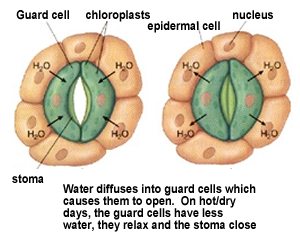Last bit of 36.1
- bulk flow is the movement of water through the plant by pressure.
In the roots, most water absorption occurs near the tips, in the root hairs.
Mycorrhizae are roots associated with symbiotic fungi. These absorb water and certain minerals.
Water and minerals in the root cortex must pass through the endodermis (the innermost layer of cells in the root cortex) in order to enter the rest of the plant. The endodermis surrounds the stele (vascular liner).
The endodermis contains the Casperian strip, which prevents substances from going around the cells. Water and minerals must therefore pass through an endodermal cell to enter the vascular tissue.

Start of 36.2
Transport of Xylem Sap
Transpiration is the loss of water vapor from the leaves and other parts of the plant in contact with air.
There are two ways in which water is pulled up through the plant, these are:
- Root Pressure occurs when water flowing in from the root cortex generates a positive pressure that forces fluid up through the xylem.
- The transpiration-cohesion-tension mechanism- water is lost through transpiration at the leaves of the plant, and this creates a negative pressure, which draws water up through the plant. The cohesion of water due to the hydrogen bonding enables it to form a column, which is drawn up through the xylem with the help of adhesion (the fact that water molecules are attracted to plant cell walls).
The Control of Transpiration
Guard cells control the size of the opening in the stomata and therefore regulates the plant cells water intake.
Guard cells control the size of the stomata opening by changing shape, widening, or closing up the gap between them. They increase in size by taking up water. This causes them to swell and seal off the stomata opening.

Three factors influencing the opening and closing of stomata are light, depletion of CO2 and air spaces in the leaf, and internal clock of the guard cells.

1 comment:
Thanks Phoebs! Good job :)
Post a Comment